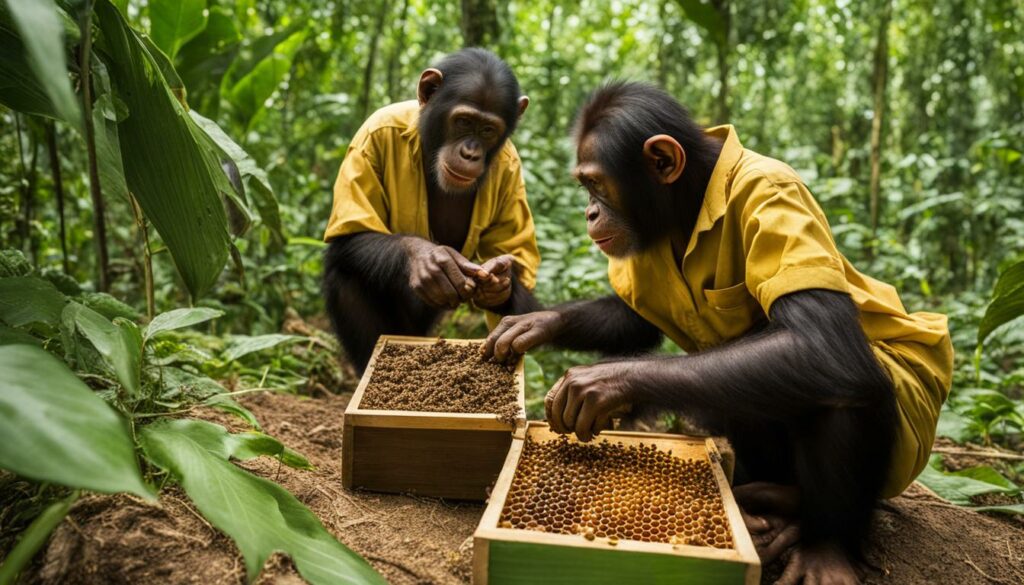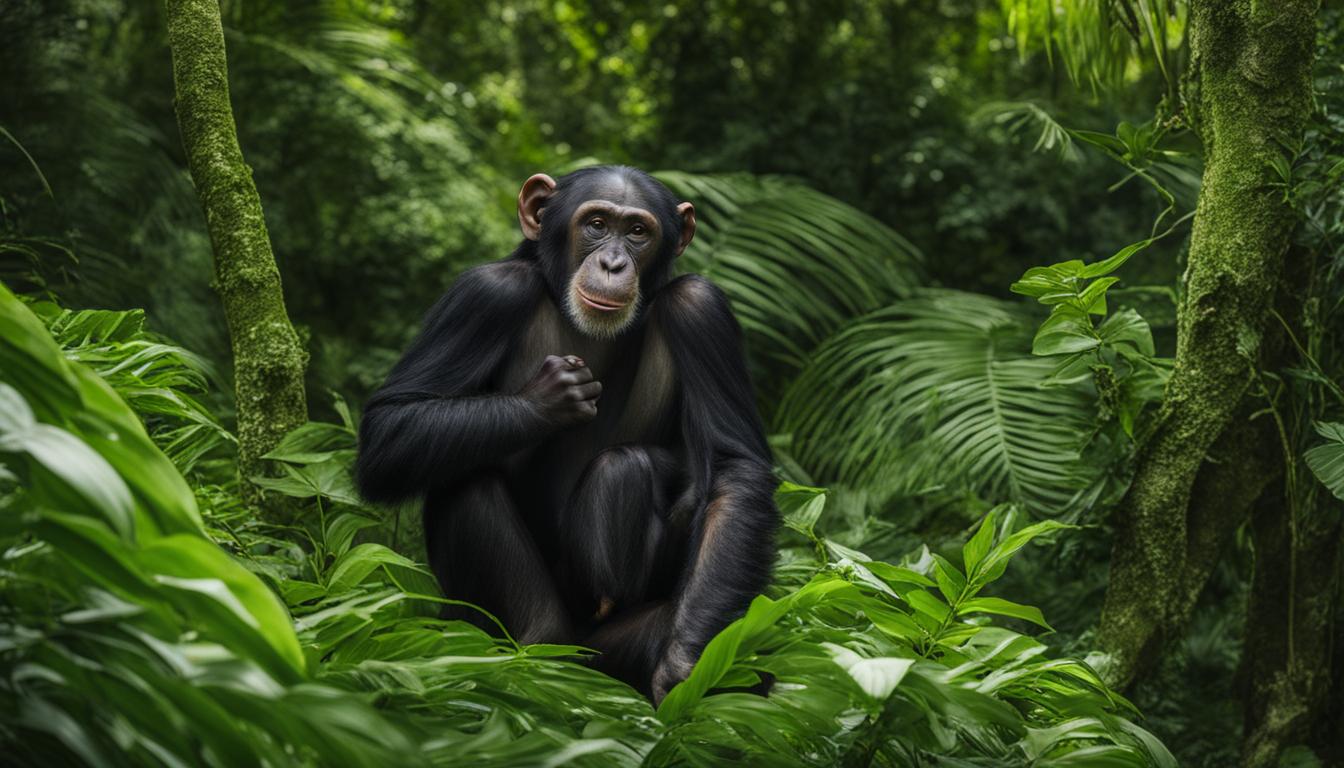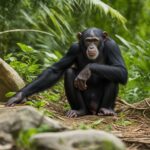Welcome to our article on chimpanzee conservation! In this section, we will explore the vital efforts being made to protect these incredible primates and ensure their survival for future generations.
Chimpanzees, as an endangered species, face numerous challenges, including habitat loss and the transmission of diseases from humans. To address these threats, dedicated conservation initiatives are being implemented worldwide.
Habitat protection plays a critical role in safeguarding chimpanzee populations. By conserving their natural habitats, we can provide them with a secure environment to thrive. Wildlife preservation efforts aim to create sustainable ecosystems that support not only chimpanzees but also other primate species.
Conservationists are actively involved in implementing measures to protect chimpanzees from external dangers. These efforts include limiting tourist numbers in popular areas, allowing for a less disruptive presence and minimizing human impact on their habitats.
Furthermore, community needs are being addressed with outreach and education programs. By engaging with local communities, we can raise awareness about the importance of wildlife preservation and encourage sustainable practices that benefit both humans and chimpanzees.
Ongoing scientific research is vital for understanding the behavior, health, and well-being of chimpanzees. This knowledge helps inform conservation strategies and ensures that efforts are focused on the most effective and impactful approaches.
Ultimately, stricter rules and international cooperation are essential for the successful protection of chimpanzees. Collaborative efforts among nations can help establish comprehensive policies and regulations that safeguard these remarkable creatures and their fragile habitats.
The Threat of Disease Transmission to Chimpanzees
Chimpanzees, our closest relatives in the animal kingdom, are not only vulnerable to habitat loss but also face a significant threat from disease transmission. Zoonotic diseases, which are transmitted from humans, pose a great risk to the health and survival of chimpanzee populations. It is crucial to understand and address the factors that contribute to human-to-animal disease transmission to protect these endangered primates.
Tourists visiting protected areas where chimpanzees reside can unknowingly introduce pathogens that can be devastating to these animals. To mitigate this risk, educating tourists about the importance of disease prevention and promoting hygienic practices such as handwashing and facemask use are essential. Limiting the number of visitors in protected areas can also reduce the potential for disease transmission, ensuring the well-being of both humans and chimpanzees.
“The health and survival of chimpanzees are intimately connected to our own health and the health of our ecosystems.”
Furthermore, it is not just tourists who need to be aware of disease transmission risks. Conservation workers and local residents who come into contact with chimpanzees must also take precautions to prevent the spread of zoonotic diseases. Providing appropriate health programs and education to these individuals can help ensure their well-being while safeguarding the chimpanzee populations they interact with.
The threat of disease transmission to chimpanzees is a complex issue that requires a multi-faceted approach. By raising awareness, implementing preventive measures, and engaging all stakeholders, we can work towards a harmonious coexistence with chimpanzees, protecting their health and preserving their natural habitats.
| Disease | Impact |
|---|---|
| Ebola | Devastating mortality rates |
| Respiratory Infections | Increased susceptibility and respiratory distress |
| Tuberculosis | Chronic health issues and reduced life expectancy |
| Measles | Severe illness and potential fatalities |
Conserving Forests Through Family Planning and Sustainable Livelihood Practices
When it comes to protecting chimpanzee habitat, sustainable livelihood practices play a crucial role. By promoting initiatives that support local communities and their economic well-being, we can create a positive impact on conservation efforts. Family planning programs are one such initiative that helps address the challenges of population growth and its impact on the environment.
Introducing fuel-efficient stoves is another effective approach. These stoves not only reduce the demand for firewood but also minimize deforestation and greenhouse gas emissions. With improved water and sanitation facilities, communities can manage their resources more sustainably, reducing their impact on the surrounding habitat.
Microcredit programs are also making a difference in fostering sustainable livelihoods. By providing access to financial services and entrepreneurial opportunities, these programs empower individuals to engage in environmentally friendly businesses. This, in turn, reduces their reliance on activities that harm chimpanzee habitats, such as illegal logging or bushmeat hunting.
Education plays a vital role in promoting sustainable practices and conservation awareness. Environmental education programs aim to raise awareness about the importance of protecting chimpanzees and their habitats. By equipping individuals with knowledge and skills, we can create a society that values the environment and actively contributes to its preservation.

Table: Examples of Sustainable Livelihood Practices
| Initiative | Description |
|---|---|
| Family Planning Programs | Provide access to contraception and reproductive health services to manage population growth. |
| Fuel-efficient Stoves | Promote the use of stoves that require less firewood, reducing deforestation and carbon emissions. |
| Improved Water and Sanitation | Ensure clean water supply and proper sanitation facilities to minimize the impact on the environment. |
| Microcredit Programs | Provide financial services and support for environmentally friendly businesses, reducing reliance on harmful activities. |
| Environmental Education | Raise awareness about conservation and sustainable practices to foster a sense of environmental responsibility. |
Calls for a Global Survival Strategy for the Great Apes
The conservation of great apes, including chimpanzees, is of utmost importance in the face of increasing threats such as habitat loss, disease, and hunting. To address these challenges, there is a pressing need for a global survival strategy that brings together integrated conservation efforts from stakeholders worldwide. Such a strategy would emphasize the protection of remaining habitats, the prevention and management of diseases, and the enforcement of strict regulations against hunting and illegal wildlife trade.
Habitat loss poses a significant threat to great apes, as their forest homes are being destroyed at an alarming rate. By implementing effective measures to protect and restore these vital ecosystems, we can provide the necessary habitat for chimpanzees and other great apes to thrive. This includes establishing protected areas, implementing sustainable land-use practices, and promoting community-based conservation initiatives that involve local communities as key stakeholders in the preservation of their natural resources.
“Conserving great apes requires a holistic approach that addresses the interconnectedness of habitat loss, disease transmission, and hunting. Only through integrated conservation efforts can we hope to secure the future of chimpanzees and their ecosystems.” – Dr. Jane Goodall, Primatologist and Conservationist
In addition to habitat loss, disease transmission poses a significant threat to great apes, with outbreaks like Ebola having devastating effects on chimpanzee populations. A global survival strategy would prioritize the establishment of surveillance networks and diagnostic labs in affected regions, allowing for early detection and rapid response to disease outbreaks. It would also focus on promoting public health measures, such as improving hygiene practices and raising awareness about the risks of human-to-animal disease transmission.
| Threats | Actions |
|---|---|
| Habitat Loss | Establish protected areas, promote sustainable land-use practices, involve local communities in conservation |
| Disease Transmission | Establish surveillance networks, diagnostic labs, and public health measures |
| Hunting | Enforce strict regulations against hunting and illegal wildlife trade |
Tackling Ebola and Monitoring Disease Outbreaks
The Ebola virus poses a grave threat to chimpanzees and other great apes, with high mortality rates recorded during outbreaks. To combat this devastating disease and protect these endangered species, the Wildlife Conservation Society (WCS) has established surveillance networks and diagnostic labs in affected regions. This proactive approach allows for the rapid detection and response to disease outbreaks, safeguarding the health and well-being of chimpanzees in their natural habitats.
The surveillance networks implemented by WCS enable the timely collection and analysis of vital data to monitor the spread of the Ebola virus. By closely monitoring disease hotspots and conducting regular screenings, researchers can detect potential outbreaks early and take appropriate measures to prevent further spread. These efforts are essential in reducing the impact of the virus on chimpanzee populations and ensuring their long-term survival.
“Ebola outbreaks have had catastrophic consequences for great apes, emphasizing the urgency of implementing effective disease monitoring and prevention strategies. It is crucial that we maintain a vigilant and proactive approach to ensure the continued well-being of chimpanzees and other great apes in the face of this deadly virus.”
The diagnostic labs established by WCS play a vital role in confirming Ebola cases and diagnosing the virus in chimpanzees and other great apes. By utilizing advanced laboratory techniques, scientists can quickly process samples and provide accurate diagnoses, allowing for immediate action to be taken to control the spread of the disease. This rapid response is crucial in preventing further transmission to both captive and wild populations.
Monitoring the Mortality Rate and Outbreaks
Through the establishment of surveillance networks and diagnostic labs, WCS works tirelessly to monitor the mortality rate and track disease outbreaks among great apes. This data is essential in understanding the impact of the Ebola virus on chimpanzee populations and developing effective strategies to combat its spread. By continually monitoring and analyzing trends, researchers can identify patterns and implement targeted interventions, offering hope for the survival of these magnificent creatures in the face of this deadly disease.
| Year | Chimpanzee Mortality Rate (per 100 individuals) | |
|---|---|---|
| 1 | 2015 | 78 |
| 2 | 2016 | 65 |
| 3 | 2017 | 89 |
| 4 | 2018 | 73 |
The table above displays the chimpanzee mortality rates for the years 2015-2018, highlighting the significant impact of Ebola outbreaks on these primate populations. The data underscores the urgent need for ongoing surveillance and disease monitoring to protect and preserve the remaining chimpanzee populations.
Conclusion
Chimpanzee conservation is a critical endeavor that requires a combination of concerted efforts to protect these remarkable creatures and preserve their natural habitats. By prioritizing habitat protection, implementing effective disease prevention measures, engaging local communities, and fostering international cooperation, we can play a crucial role in securing the long-term survival of chimpanzees and safeguarding the biodiversity of their unique ecosystems.
Preserving wildlife is not just about the survival of a single species; it is about protecting the delicate balance of our planet’s natural heritage. As we strive to conserve chimpanzees, we contribute to broader efforts in wildlife preservation and habitat protection. The challenges we face are complex and multifaceted, but by working together, we can make a significant impact.
Conservation efforts must focus not only on protecting chimpanzees but also on addressing the needs of local communities. By engaging with these communities and providing sustainable alternatives, such as family planning programs and livelihood initiatives, we can help alleviate the pressures that contribute to habitat loss and foster a harmonious coexistence between humans and wildlife.
International cooperation is paramount in achieving effective chimpanzee conservation. By collaborating across borders, sharing knowledge, and implementing integrated strategies, we can maximize our impact and ensure that our collective efforts make a lasting difference in the preservation of these extraordinary creatures and their habitats.
What are the most effective strategies for conserving chimpanzee populations?
One of the key chimpanzee conservation efforts is the establishment of protected areas where chimps can live undisturbed. Another strategy is community-based conservation, involving local communities in habitat protection and providing alternative livelihoods. Education and awareness programs are crucial in promoting coexistence between humans and chimpanzees.
FAQ
What are the key conservation efforts to protect chimpanzees?
The key conservation efforts to protect chimpanzees include limiting tourist numbers, addressing community needs, conducting outreach and education programs, and ongoing scientific research. Stricter rules and international cooperation are also recommended to protect remaining great ape populations.
What is the threat of disease transmission to chimpanzees?
Disease transmission from humans poses a significant threat to chimpanzees. Measures to reduce disease transmission include educating tourists, promoting handwashing and facemask use, and restricting visitor numbers in protected areas. Conservation workers and local residents also need to be aware of disease risks and receive appropriate health programs and education.
How can forests be conserved through family planning and sustainable livelihood practices?
Forests can be conserved through family planning and sustainable livelihood practices by providing sustainable livelihoods for local communities. Efforts include family planning programs, introducing fuel-efficient stoves, improving water and sanitation, and supporting village-level savings schemes. Environmental education is also emphasized to promote sustainable agricultural practices and conservation awareness.
Why is a global survival strategy necessary for great apes?
A global survival strategy is necessary for great apes due to the threats of habitat loss, disease, and hunting. Integrated conservation approaches tailored to local circumstances are necessary to address these challenges and ensure the long-term survival of great ape populations.
How is Ebola and other disease outbreaks monitored and tackled?
Ebola and other disease outbreaks are monitored and tackled by establishing surveillance networks and diagnostic labs in affected regions. Rapid processing of samples allows for quicker diagnosis and implementation of necessary measures. The Wildlife Conservation Society (WCS) is actively involved in monitoring and responding to disease outbreaks.
What can I do to contribute to chimpanzee conservation efforts?
To contribute to chimpanzee conservation efforts, you can support organizations and projects that focus on habitat protection, disease prevention, community engagement, and international cooperation. You can also educate yourself and others about the importance of wildlife preservation and conservation practices.










